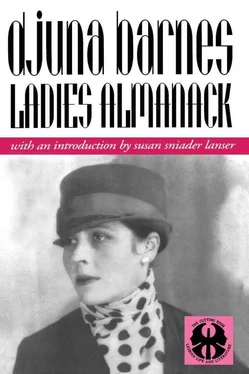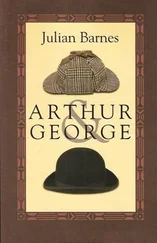By identifying its author only as a “Lady of Fashion” and its main character as “Dame,” the book recognizes and perhaps mocks Barney’s wealthy status and at the same time turns the traditionally chaste figure of the “lady” into a lesbian: all “ladies” should carry this Almanack, “as the Priest his Breviary, as the Cook his Recipes, as the Doctor his Physic, as the Bride her Fears, and as the Lion his Roar!”(9). It has been suggested that the Almanack form was inspired by the legend that James Joyce was never without his book of saints, but Barnes may also have known the eighteenth-century English journal LADIES Diary or Woman’s ALMANACK , which has a subtitle almost as elaborate as her own. Barnes might at the same time have been responding to a famous line from her allegedly favorite book, Burton’s Anatomy of Melancholy (1621), as if to show just what would happen in a future where “women wear the breeches” in “a world turned upside downward.” 16The Almanack responded to contemporary literature as well. In her 1972 Foreword Barnes placed it “neap-tide to the Proustian chronicle,” and certainly the women in Barney’s circle had sharply criticized Proust’s representation of lesbians in the Sodom and Gomorrah section of Remembrance of Things Past . Barnes may also have been “correcting” Radclyffe Hall’s Well of Loneliness , which appeared in July of 1928 and which features Natalie Barney as “Valérie Seymour.” And there are echoes of Ryder in Ladies Almanack that go beyond their shared Rabelaisian iconography.
The language of Ladies Almanack is as varied and complex as its generic mixture: a dense and highly allusive prose enshrouded in capital letters that speaks sometimes clearly, sometimes cryptically. Archaisms and neologisms are oddly allied; plain modern English coexists with ornate Elizabethan; esoteric words are juxtaposed with blunt Anglo-Saxon; antecedents get misplaced, verbs dangle, pronouns lose their source. Like the writings of Gertrude Stein, Ladies Almanack is bent on serious nonsense — and like Stein’s probably embeds a host of private allusions that may never be unlocked, so it seems wise to take Barnes’s advice to “honour the creature slowly,” savoring rather than belaboring such phrases as “she thaws nothing but Facts” (37); “Outrunners in the thickets of prehistoric probability” (43); or “two creatures sitting in Skull” (51). Resonating with the language of Chaucer, Shakespeare, Swift, Sterne, and Fielding, Ladies Almanack seems bent on writing lesbian experience into English Literature.
Exactly how Barnes’s book should be called “lesbian” remains, however, a subject of inquiry. The book’s perspective and tone are by no means unambiguous, and the “meaning” of Ladies Almanack has become a site of lively critical debate. Is the book a light parody or a bitter attack? Is it a celebration or a condemnation of Barney and her community? Does it revise or repeat the tropes of homophobic ideology? The few critics of the 1960s and early 1970s who discussed the book at all saw it as a critique of the community it parodies. James Scott — possibly influenced by the “later” Barnes, who cast a censoring eye over his critical study — calls it a protest against “the absurdity of female promiscuity,” “the sterility of the sisterhood,” and “the absence of decent restraints of privacy,” as if it were a document of Victorian morality. 17Louis Kannenstine finds moments of “Sapphic manifesto” in Ladies Almanack but sees its humor as “surface levity” concealing a “pain-racked comedy” documenting the “horror” of “coming back upon oneself.” 18Emphasizing its positive vision, Andrew Field nonetheless calls it “a queer little book” whose “finest portions are about melancholy.” 19In sharp contrast, Bertha Harris hailed the 1972 Ladies Almanack as “a document of lesbian revolution” and Catharine Stimpson recently insisted that “Barnes is clear-tongued about lesbianism. No one would mistake the ebullient Ladies Almanack … for a handbook about the joys of heterosexuality.” 20To my 1979 essay reading Ladies Almanack as a text of celebration, other critics have responded with varying degrees of assent and difference. 21Shari Benstock concurs that Ladies Almanack is “not a satire at the expense of lesbianism or of such groups as Natalie Barney established” and that it “deplores the treatment of women in the heterosexual world.” 22Cheryl Plumb sees the work as part celebration and part inquiry into “opposing ideas of love, sexuality, and the role of the artist and imagination.” 23For Frann Michel, however, the book “is always potentially compromised by that which it subverts.” 24And Karla Jay, in perhaps the most oppositional reading, has argued that Ladies Almanack is a bitter attack on the upper-class Barney, who doled handouts to Barnes and other women artists who had insufficient means of support. For Jay, many of the details in Ladies Almanack that I find to be lighthearted parodies or inside jokes are vituperous jibes at Barney and such other figures as Radclyffe Hall that distort their values and represent lesbianism in “reductionist” ways. 25If Ladies Almanack is indeed an attack on its own characters, many of them seem to have missed the point: Janet Flanner loved the book and boasted of her inclusion; Solita Solano wrote in 1967 that she had “reread ‘Ladies Almanack’ and had nearly forgotten how charming and amusing it is”; and Barney wrote throughout the sixties that “Your ‘Ladies Almanack’ is a constant joy to me” and that “I have just reread your ‘Ladies Almanack’ with new finds and delights.” 26
Mediating these divergent readings, Benstock notes that Ladies Almanack’s satire necessarily “cuts both ways”: while the book is addressed to “a small and select audience of lesbians,” still “the attitudes supporting its satire belong to the modernist mainstream, which in general hated Sapphism and in particular resented the wealth and leisure of this group.” 27Without question, Ladies Almanack is often irreducibly ambiguous, its narrative voice evasive and devious—“a Maze, nor will we have a way out of it” (58). Each reader, then, will have to construct it (as, of course, we construct all texts) after his or her desire.
My own desire continues to see Ladies Almanack primarily as a celebratory spoof written for insiders, though not without moments of what we would today call “internalized homophobia.” I read in the Almanack three different kinds of writing: ribald and accessible narrative chapters that tell the story of Dame Musset and her missions to women in sexual distress; sequences that fashion an amazonian mythology; and ambivalent, often cryptic social and philosophical ponderings. These three kinds of discourse are often interwoven, and their boundaries blur: a myth about women’s Edenic origins slides into the narrative line as Eve becomes one of Dame Musset’s lovers; discussions among Dame Musset’s friends become an essay-in-dialogue; a single page juxtaposes poem and picaresque. As it proceeds, the Almanack becomes at once more radical and more dense linguistically, until the narrative turns both clear and mythic in a climactic account of Dame Musset’s death. The almanack form allows time to be both linear and cyclical, and perhaps this is one reason why Barnes often chose it: given her preoccupation with the relentless movement of history, it may have afforded a way to mark time’s passage without despair.
In writing the history of its protagonist, Ladies Almanack attacks and parodies contemporary “sexology.” The fearsome lesbian seducer is here celebrated as “one Grand Red Cross” for women’s sexual relief. And although the text will suggest that some women discard “Duster, Offspring and Spouse” to become lesbians in middle age, Dame Musset is, as it were, born a lesbian. She was intended, says the narrator with what I consider to be tongue in cheek, 28to be a boy, but when she “came forth an Inch or so less than this, she paid no Heed to the Error” (7), and to her father’s worries that her conduct would “by no Road, lead her to the Altar,” Evangeline retorts that since he was “expecting a Son,” why “be so mortal wounded when you perceive that you have your Wish? Am I not doing after your very Desire, and is it not the more commendable, seeing that I do it without the Tools for the Trade, and yet nothing complain?” (8). Such a scene rewrites Stephen Gordon’s birth in The Well of Loneliness : he too was “meant” to be a son (and like Evangeline named with saintliness in mind), but Stephen’s phallic Lack becomes Evangeline’s signifier of superiority.
Читать дальше












